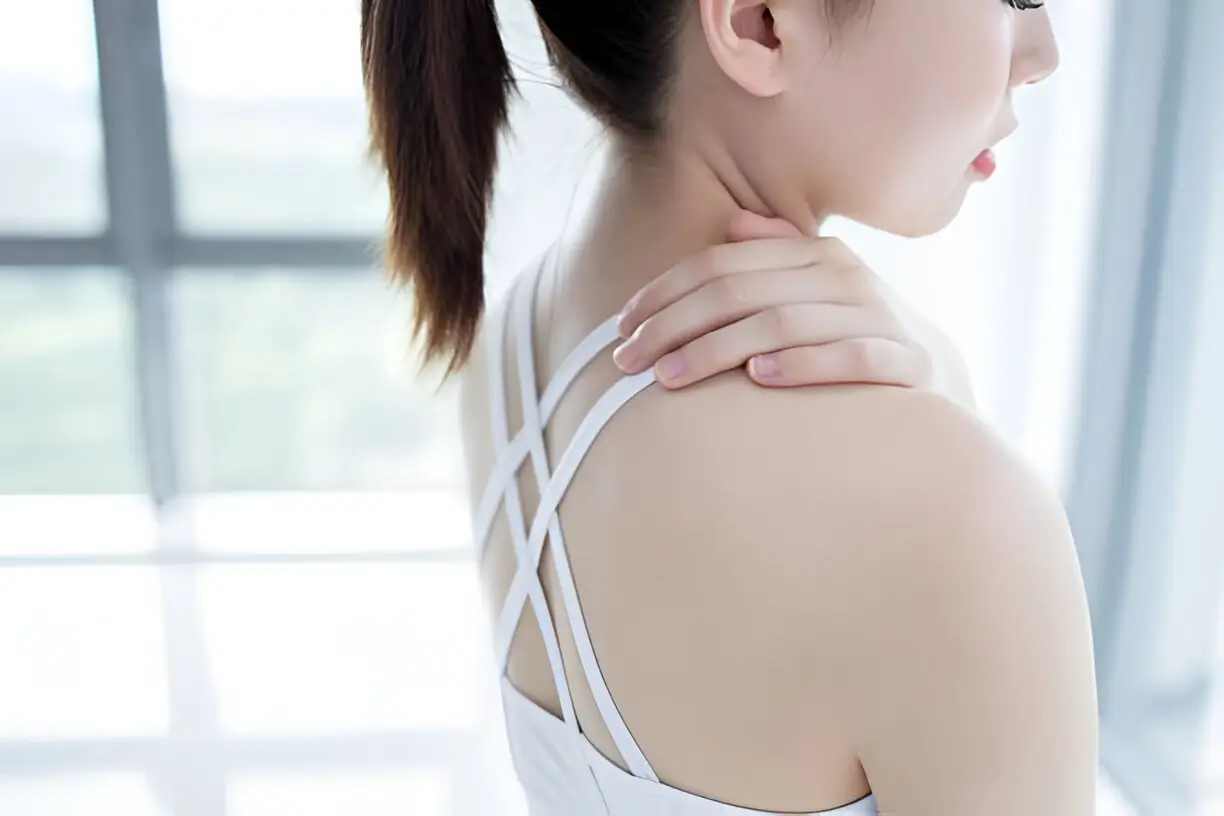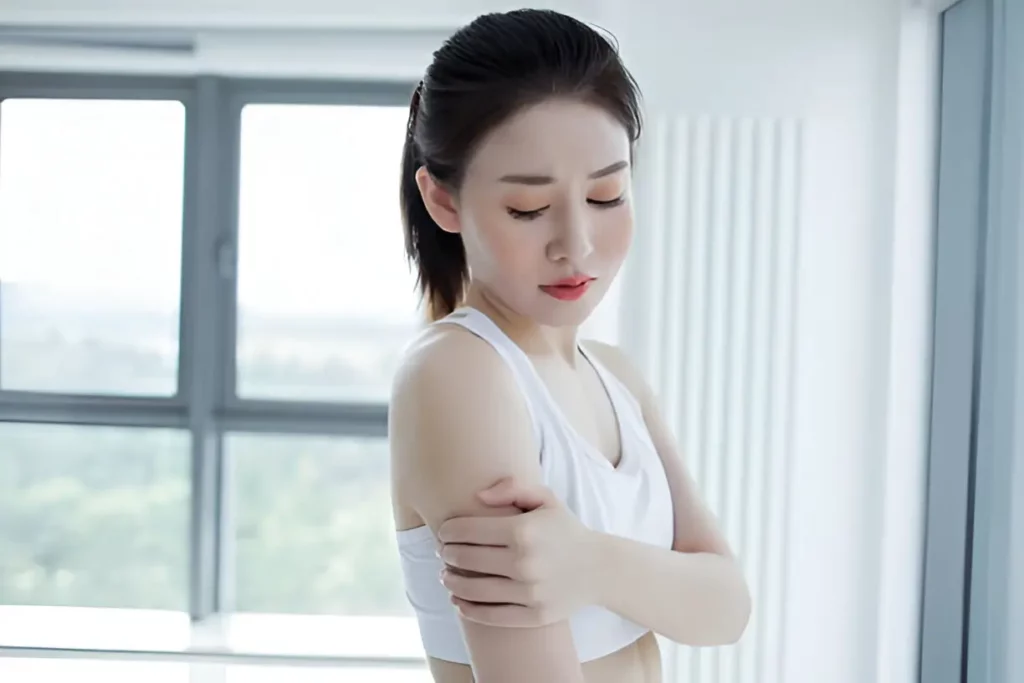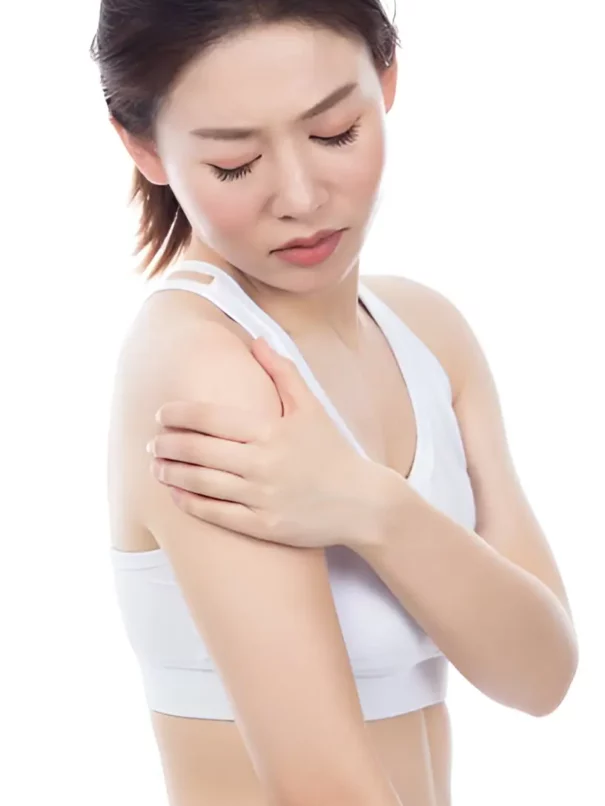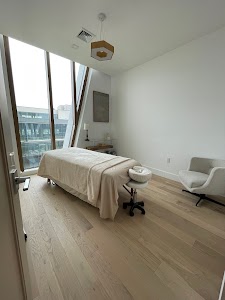Acupuncture for Bursitis
Acupuncture for Bursitis
What Is Bursitis?

Bursitis is a painful condition that affects the small fluid-filled sacs, known as bursae, which cushion the joints, bones, muscles, and tendons. When these bursae become inflamed, they can cause discomfort and limit movement in the affected areas. The main causes are usually repetitive joint movements, injuries, or prolonged pressure on a joint. Though bursitis can occur in various parts of the body, common locations include the shoulder, elbow, hip, knee, and foot. In recent years, people have turned to natural treatment for bursitis, such as acupuncture, to help manage bursitis symptoms.
Types of Bursitis
The most common types of bursitis include:
- Shoulder Bursitis. The shoulder contains several bursae that can become inflamed, causing pain and limited movement, especially when lifting the arm. This condition is common in individuals who perform repetitive overhead movements, such as athletes, painters, and carpenters. Acupuncture for shoulder bursitis can make it hurt less because it stimulates acupuncture points around the elbow, reducing swelling.
- Trochanteric Bursitis. It is a common type of hip bursitis that affects the outer part of the hip, near the large bony prominence known as the greater trochanter. This condition often results from repetitive stress or overuse, leading to inflammation of the bursa. People with trochanteric bursitis may experience sharp or aching pain in the hip, which may worsen with walking, climbing stairs, or lying on the affected side. Acupuncture for trochanteric bursitis can help treat trochanteric bursitis by targeting specific acupuncture points near the hip and increasing circulation to reduce inflammation.
- Elbow Bursitis. Often referred to as “student’s elbow” or “plumber’s elbow,” this type of bursitis affects the pointy part of the elbow. Bursitis in the elbow can result from leaning on the elbows for extended periods, causing swelling, tenderness, and discomfort. Acupuncture for elbow bursitis can reduce elbow bursitis by stimulating acupuncture points around the elbow, promoting healing, and reducing swelling.
- Knee Bursitis. Bursitis in the knee typically affects the area around the kneecap or on the inner side of the knee. This condition is prevalent in individuals who kneel frequently, such as gardeners, plumbers, or athletes. Knee bursitis can make walking and bending the knee painful. You’ll need acupuncture for knee bursitis if a simple movement like standing up or walking causes you any discomfort, burning or pain. If it’s done properly, the symptoms may disappear for a long time.
- Hip Bursitis. What is bursitis of the hip? The hips contain several bursae that can become inflamed due to injury, overuse, or prolonged pressure. Symptoms of hip bursitis: may cause pain on the outside of the hip, groin, or buttock area and is more common in people who perform repetitive movements, such as runners and cyclists. Acupuncture for hip bursitis can help reduce the severity of pain and discomfort caused by bursitis in this area. Acupuncture for bursitis in hip can make some changes in your daily life, you’ll be able to perform your daily activities with no pain.
Foot Bursitis. This type of bursitis can affect the heel, the Achilles tendon, or the ball of the foot, causing pain, swelling, and discomfort while walking or standing. Foot bursitis is common among runners, dancers, and people who wear poorly fitting shoes. Acupuncture for bursitis in foot can help to reduce symptoms for optimal performance.
What Causes Bursitis?
Bursitis is typically caused by repetitive movements, injury, or prolonged pressure on a joint. Activities that require repetitive use of a particular joint, such as lifting, kneeling, or leaning on the elbows, can irritate the bursae and lead to inflammation. Other common bursitis causes include:
- Repetitive Motion: engaging in repetitive activities that involve the same joint can lead to irritation and inflammation of the bursae. This is common in individuals who work in professions that require repetitive movements, such as carpenters, athletes, and musicians.
- Injury or Trauma: a direct injury to a joint, such as a fall or blow, can cause the bursa to become inflamed. This type of acute bursitis may develop suddenly and result in severe pain and swelling.
- Prolonged Pressure: applying constant pressure to a joint, such as kneeling or leaning on the elbows for long periods, can irritate the bursae. This is common in individuals who spend long hours working on their knees or elbows.
- Age-Related Wear and Tear: as people age, their tendons and bursae become less flexible and more prone to injury. Older adults are at a higher risk of developing bursitis due to the natural aging process, which weakens the joints and surrounding tissues.
Infection: in rare cases, bursitis can be caused by an infection known as septic bursitis. This occurs when bacteria enter the bursa, leading to inflammation, swelling, and redness. Septic bursitis requires immediate medical attention and treatment with antibiotics.
If you are worried about Bursitis, make an appointment with us!
Bursitis Symptoms

The primary hip bursitis symptoms include pain in the affected joint. The pain may be gradual or sudden, depending on the cause of inflammation. Other common symptoms include:
- Swelling: The affected joint may become swollen and tender to the touch.
- Limited Range of Motion: Moving the joint may be painful, and individuals with bursitis may experience difficulty performing everyday tasks that require joint movement.
Warmth and Redness: In cases of septic bursitis, the skin over the affected joint may become warm and red due to infection.
Bursitis Risk Factors
Several factors can increase the risk of developing bursitis, including:
- Age: older adults are more likely to develop bursitis due to age-related wear and tear on the joints.
- Repetitive Activities: engaging in repetitive activities that involve the same joint increases the risk of bursitis. This is common in athletes, manual laborers, and individuals who perform repetitive tasks as part of their job.
- Occupation: people who work in professions that require frequent kneeling, leaning, or lifting are at higher risk of developing bursitis. Examples include plumbers, electricians, carpenters, and athletes.
Medical Conditions: conditions such as rheumatoid arthritis, gout, and diabetes can increase the risk of bursitis. These conditions cause inflammation in the joints, making the bursae more prone to irritation. They are also definitive factors on how long bursitis lasts.

Can Acupuncture Help Bursitis?
Acupuncture is a complementary therapy that has been used for centuries to relieve pain, reduce inflammation, and promote healing. By inserting thin needles into specific points on the body, acupuncture stimulates the nervous system and promotes the release of natural pain-relieving chemicals, such as endorphins. This natural remedy for bursitis helps to reduce the pain associated with bursitis and reduce inflammation in the affected joint.
Here are some of the key ways acupuncture can help individuals with bursitis:
- Pain Relief: targets specific points in the body to help relieve pain in the affected joint. By stimulating these points.
- Reduction of Inflammation: acupuncture for tendonitis has been shown to reduce inflammation in the body, including the inflammation in the bursae that causes bursitis. This reduction in inflammation helps to alleviate pain and swelling.
- Improved Joint Mobility: acupuncture can help improve joint mobility by relaxing the muscles and tendons around the affected joint. This allows them to move more freely without experiencing pain or stiffness.
Promotes Healing: by improving circulation and stimulating the body’s natural healing processes, things like acupuncture points for hip bursitis can speed up the recovery process for individuals with bursitis.
Acupuncture for Bursitis at Pulse Acupuncture
At Pulse Acupuncture, with locations in Clifton, NJ, and Williamsburg, Brooklyn, Marina Doktorman, L.Ac., offers specialized acupuncture bursitis treatment. Marina has a holistic and safe approach to managing bursitis by focusing on the root cause of the inflammation and pain.
Each treatment plan is personalized to address the specific needs of the patient, whether they are experiencing shoulder, knee, elbow or hip bursitis pain. Marina’s expertise ensures that patients receive the most effective treatment possible to reduce pain, improve mobility, and enhance overall well-being.
In addition to acupuncture, Marina offers guidance on lifestyle modifications and exercises that can help prevent bursitis flare-ups and support long-term joint health.
Bursitis can significantly impact a person’s quality of life by causing pain, limiting joint movement, and affecting everyday activities. While rest, medication, and lifestyle adjustments are common treatments for bursitis. Acupuncture and red light therapy for hip bursitis has a natural approach to managing symptoms and promoting healing.
If you’re looking for acupuncture for bursitis, at Pulse Acupuncture, with locations in Clifton, NJ, and Williamsburg, Brooklyn, Marina Doktorman, L.Ac., does acupuncture for bursitis, having a safe approach to make the illness less painful and improving joint function. Сonsider scheduling an appointment at Pulse Acupuncture to explore the benefits of acupuncture services for joint health and overall wellness.
-
Marina Doktorman, M.S., L.Ac., is an experienced acupuncturist who obtained her Masters of Acupuncture from the Tri-State College of Acupuncture in New York City in 2001. During her studies, she focused on Chinese Herbology, a branch of Traditional Chinese Medicine (TCM) that utilizes herbs to complement acupuncture treatments. Marina is licensed in both New York (NY) and New Jersey (NJ) and holds a Diplomate of Acupuncture from the National Certification Commission for Acupuncture and Oriental Medicine (NCCAOM), indicating her expertise in the field.
Why Pulse Acupuncture?

Experience
Marina Doktorman, L.Ac. has over 20 years of clinical experience.

RELAXATION
At Pulse Acupuncture, we aim to cultivate a spa-like environment.

Comfort
All of our needles are of the highest quality for painless insertion.
Patient Reviews in Brooklyn

Marina is very accommodating, kind, and attentive, and her staff is a pleasure to deal with. I highly recommend Pulse.
Acupuncture has truly changed my life and has helped me in ways I didn’t even know were possible.
I started doing acupuncture to balance my hormones after 2 years of unsuccessful fertility treatments. When I started seeing Marina, my periods were starting to be regular and I was dealing with a few different symptoms which we started treating right away (constipation, random headaches, body aches)… in the last 3 years I have not been sick (no flu, have never tested positive for COVID) - Marina even treated me for allergies more than a year ago during an allergy episode in changing seasons.
Also want to mention Larissa as I started seeing her in Marina’s beautiful office and she’s also contributed to my wellness journey. Acupuncture is my favorite wellness practice, I see them regularly and have never felt better. I sometimes just tell them whatever I’m thinking/feeling knowing they will stick some needles in different places of my body and I come out floating and feeling so relaxed.
Excellent service- great results- highly recommended ~!
Marina is not only incredibly knowledgeable, but also very calming and has great bedside manners. If you're looking for a fantastic acupuncturist I can't recommend her enough!!
After 10 minutes of the procedure, you get into a different reality. Marina is knowledgeable, answers all the questions. After the procedure, the skin of the face glows, the body becomes lighter by a couple of pounds. I've been looking for such a procedure and state of mind for a long time.
I am beyond grateful to Marina, because after trying so many things, I almost lost hope. highly recommend Pulse Acupuncture and Marina for anyone seeking relief from pain or other health concerns.
The acupuncture sessions themselves are incredibly relaxing and therapeutic. Marina's gentle touch and precise needle placement always leave me feeling calm and rejuvenated. She also incorporates other techniques, such as cupping, which have been very beneficial for my overall health and wellbeing.
In addition to her skill as an acupuncturist, Marina is also a wonderful person to work with. She is warm, friendly, and genuinely cares about her clients' wellbeing. I always leave our sessions feeling refreshed and uplifted, both physically and mentally.
Overall, I highly recommend Pulse Acupuncture and Marina for anyone looking for high-quality acupuncture and personalized care. Thank you, Marina, for your exceptional service and dedication to helping others achieve optimal health!
Acupuncture for Bursitis - FAQ
What Is Bursitis?
Bursitis is the inflammation of the bursae—small, fluid-filled sacs that cushion the bones, tendons, and muscles near your joints. Common areas affected include the shoulder, elbow, hip, and knee. Symptoms often include pain, swelling, and reduced mobility in the affected joint.
Is Acupuncture Good for Bursitis?
Acupuncture may offer relief for some individuals with bursitis. By inserting fine needles into specific points on the body, acupuncture aims to reduce inflammation, alleviate pain, and promote healing. While some people report significant improvements, results can vary. It’s advisable to consult a healthcare professional to determine if acupuncture is a suitable option for your condition.
What Is Bursitis of the Hip?
Bursitis of the hip, also known as trochanteric bursitis, occurs when the bursae in the hip become inflamed. This leads to pain on the outer side of the hip and thigh, especially during activities like walking, climbing stairs, or lying on the affected side.
How Long Does Bursitis Last?
The duration of bursitis can vary. Acute bursitis may resolve within a few days to weeks with proper rest and treatment. Chronic bursitis, on the other hand, can persist for months or even become a recurring issue if the underlying causes aren’t addressed.
Contact us
Acupuncture therapy at Pulse Acupuncture Practice, at Clifton, NJ and Williamsburg, Brooklyn, NYC offers unique combination of various cupuncture types for healing on all levels: emotional, spiritual and physical by integrating ancient wisdom of energy healing with modern acupuncture techniques.
















































